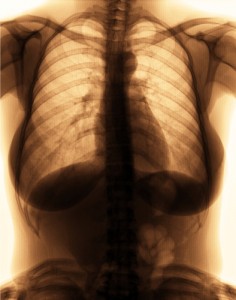 Chronic obstructive pulmonary disease (COPD) or chronic obstructive lung disease (COLD) is an “umbrella term” that represents a host of conditions that cause obstruction of airflow inside the lungs. COPD is a progressive condition that leads to chronically poor airflow, and if not treated properly, may eventually lead to premature death. As a diagnosis, COPD can refer to either one or a combination of the following conditions: chronic bronchitis (long term cough with sputum), emphysema (progressive destruction of lungs), and asthma (obstruction of airways due to chronic swelling).
Chronic obstructive pulmonary disease (COPD) or chronic obstructive lung disease (COLD) is an “umbrella term” that represents a host of conditions that cause obstruction of airflow inside the lungs. COPD is a progressive condition that leads to chronically poor airflow, and if not treated properly, may eventually lead to premature death. As a diagnosis, COPD can refer to either one or a combination of the following conditions: chronic bronchitis (long term cough with sputum), emphysema (progressive destruction of lungs), and asthma (obstruction of airways due to chronic swelling).
The main cause of COPD is exposure to cigarette and tobacco smoke. Exposure to air pollutants, allergens, and carcinogenic gases also contribute to the onset of the disease. Inflammation of the airways causes insufficient mucociliary clearance, which eventually harbor bacteria and cause ‘flare-ups’ (exacerbations) that lead to worsening of health and a decreased quality of life.
Diagnosis of COPD requires special attention and care from medical practitioners, since the conditions related to COPD can lead to other conditions with similar end-results (such as bronchiectasis and bronchiolitis, among others).
Around 32 million people in the United States, 3 million in the UK, and almost 5% of the global population is diagnosed with COPD each year. The high diagnosis rate of the disease is having a significant impact on global health, and is becoming an increasing public health concern among health organizations and drug developers alike.
Common symptoms for COPD include the production of colorless sputum in the early onset of the disease that over time turns greenish due to the presence of excess mucus. This excess mucus leads to acute chest illness, breathlessness, wheezing, and severe symptoms, which include tachypnea (rapid breathing), respiratory distress with routine physical activity, and pulmonary edema.
Treatment measures for COPD include lifestyle changes to reduce exacerbations, secondary treatments to prevent bacterial influx, and mucolytic medication to restore the consistency and quality of mucus.
Timely and proper diagnosis of COPD is the key to a successful treatment regime.

Epidemiology:
Since the initial symptoms of COPD begin with non-specific cough and discomfort, most cases of the disease are diagnosed at a much later stage, and early symptoms are often undiagnosed and untreated. Because of this, the number of people with COPD is largely unknown, and current figures are just a rough estimate.
A survey conducted jointly by the National Center for Health Statistics (NCHS) and the Centers of Disease Control and Prevention (CDC), known as the National Health Interview Survey, revealed that on being asked about a history of chronic bronchitis and/or emphysema in the past 12 months, 12.7 million people admitted to having a history of these two conditions. However, when compared with other studies, it was found that around 24 million people had been affected with impaired lung function diseases. This shows that most people who re diagnosed with COPD are either not aware of it, or leave it untreated. Thus, the data for this demographic is largely unknown.
The National Health Interview Survey also brought to light that chronic bronchitis is prevalent among 24 out of every 100 people, and emphysema affects 18 out of every 100 people.
COPD affects around 32 million people in the United States, and is the fourth leading cause of death. The highest prevalence of COPD, 22.2% in men and 16.7% in women, is found in Cape Town, South Africa, with the lowest prevalence being in Hannover, Germany, with 8.6% in men and 3.7% in women.
COPD was thought to be more prevalent in men (11.5%) than women (8.5%), but recent studies undertaken by the American Lung Association (March 2013) have suggested a change in the trend, with women being twice as prone to chronic bronchitis than men (56.7/1000 in women against 29.6/1000 in men). Women marginally surpass the number of men being affected by emphysema as well (21.4/1000 in women against 19.0/1000 in men). This is because of the increase in the number of women who smoke over the past decades.
The number of deaths due to COPD has been greater in women over the past decade (1999-2009 data) as well, but the rate of deaths in men have been 1.3 times as those in women. This is due to the fact that there are more women in the U.S. than men.
Another study has shown that in developing countries, one out of every 32 people are affected by COPD, whereas those in developed countries have a lesser prevalence (one out of every 98 people). Lack of awareness of the disease and socio-economic pressures have been attributed to this disparity.
 Etiology:
Etiology:
Tobacco smoke accounts for the primary risk factor in more than 90% of the cases of COPD. It has been observed that 15% of the people who smoke develop clinically significant (and progressively worsened) COPD. However, the actual number is likely higher than the estimate, since so many cases go under-diagnosed. Additionally, the smoking history of a patient helps in predicting the chances of COPD in patients. Smoking is directly responsible for a decrease in the forced expiratory volume in the lungs (FEV: amount of air exhaled in a second after full inspiration in forced breathing) by as much as 60ml/y as compared to the normal physiology of 20-30ml/y.
Even for people who are not active smokers, they can be directly affected from smokers around them, particularly if they are consistently exposed to, second-hand smoke, which is also a cause for COPD cases. In fact, non-smokers have a 25-45% chance of getting COPD. Environmental pollution, allergens, and toxic chemicals also contribute to increased risk of respiratory diseases and reduction of pulmonary functions. Coal/hard-rock miners and tunnel workers who have been exposed to organic and inorganic dust are also at a considerable risk of being diagnosed with COPD. However, for non-smokers, COPD affects patients at an older age (average 50 years), whereas only 2% of the total (non-smoking) population s affected.
The use of biomass fuel (cattle dung, wood, charcoal), mostly in developing countries in houses with poor ventilation also increases the risk of respiratory illness.
Genetic factors have not been found to be significant in cases of COPD. However, one gene, the alpha1-antitrypsin, controls and regulates the effect of enzyme neutrophil elastase (an enzyme released by neutrophils that hydrolyses pulmonary elastin protein, and causes fibrosis and loss of elasticity of lungs). The deficiency of this enzyme can lead to emphysema related to loss of elasticity and capacity of lungs and alveolar sacs – a principal contributor to development of COPD.
 Intravenous drug (IVD) use contributes to 2% of COPD cases, with the filters (made of cellulose and cornstarch) of methadone and methylphenidate being the culprits in this case, which cause vascular damage in the lower lobes of the lungs. Injecting cocaine and heroin intravenously can lead to pulmonary bullae (sacs full of liquid, resembling blisters) in the upper lobes of the lungs.
Intravenous drug (IVD) use contributes to 2% of COPD cases, with the filters (made of cellulose and cornstarch) of methadone and methylphenidate being the culprits in this case, which cause vascular damage in the lower lobes of the lungs. Injecting cocaine and heroin intravenously can lead to pulmonary bullae (sacs full of liquid, resembling blisters) in the upper lobes of the lungs.
Immunodeficiency syndromes (HIV infection) and/or a compromised immune system (eg: infection with Pneumocystis carcinii) have also been observed as independent risk factors for COPD, causing bullous lung damage.
Inherited connective tissue disorders like Cutis lax a, Marfan syndrome, Ehlers-Danlos syndrome, and Salla disease (causing accumulation of sialic acid in lysosomes) increase risks of COPD as well.
Pathophysiology:
The basic cause behind the development of COPD is obstruction of central airways, damage to lung parenchyma, and the small (peripheral) bronchioles. The pathophysiology of COPD involves a host of different pathogenic mechanisms, but a major chunk of them are triggered due to exposure to cigarette or tobacco smoke. Inflammation caused as a result of this initiates secretion of polymorphonuclear leukocytes (PMNL) and macrophages, which are mediators of immune responses in the host. They release catabolic enzymes like elastase (human leukocyte elastase), proteinase, and macrophage-derived matrix mrtalloproteases (MMP), and secrete pro-inflammatory cytokines and peptides (like TNF-α, IFN-γ, C-reactive protein, etc.), which lead to chronic inflammation. Elastase and proteases secreted in excess lead to hydrolysis of elastin, which in turn causes loss of elasticity of the lung chambers. MMPs contribute to breakdown of extracellular matrix and degradation of collagen, triggering a more severe immune response.

I was diagnosed with C.O.P.D 12 months ago.
I have had Severe C.O.P..D DIAGNOSED approx 12 months ago and have to spend 8 hours 8 hours a day on oxyegan
Thank you.
i have had C.O.P.D. NOW OVE 17 YEARS AND MUST SAY GETTING HARDER NOW FOR ME TO WALK FAR AS I GET OUT OF BREATH AND I AM ON 1 LITRE OF OXYGEN FOR 16 HRS A DAY.
I have ehlers danlos syndrome. over 30 years ago I gave up smoking as I kept getting chest tightness and stickiness in the back of my throat and chest. two years ago I was diagnosed with sarcoidosis. I have asthma as well, am not under a consultant ,I dont know anything about it. Feel tired a lot, smetines cant aydown at night, got the stickines ack, when I have bloodtests,shows up that I have an infection.